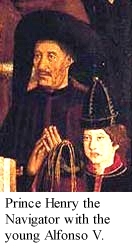The End of Europe's Middle Ages
This chapter is composed of five sections: Introduction, England, France, Spain, and Portugal. Please follow the link at the end of each section to read the entire chapter.
Portugal
As in Castile, the nobility was the major source of rebellion in Portugal and the royal succession was regularly disputed. The continual disputation of succession was exacerbated by the policy of intermarriage between the royal houses of Portugal and Castile that was initiated by Diniz of Portugal (1261-1325) and Ferdinand IV of Castile and León (1286?-1312) to end the wars between their two kingdoms.
During his reign from 1279 to 1325, Diniz of Portugal provided vigorous encouragement to Portuguese agriculture and commerce, founding schools for the study of agriculture. He made Portuguese the official language of the law courts and his interest in learning and the arts prompted him to found a university at Lisbon in 1290 (it was later moved to Coimbra in 1306). In 1294, he signed a commercial treaty with England and created a royal navy in 1317.
Alfonso IV the Brave (1290-1357), followed his father as king of Portugal in 1357. Alfonso IV allied with Alfonso XI of Castile and León to defeat the Moors at the Battle of Salado River in 1340. Although he was a capable administrator, the dynastic murder of his daughter-in-law blackened Alfonso IV's name and briefly turned his son, Dom Pedro, against him. The two were soon reconciled and Pedro succeeded his father in 1357 as Pedro I of Portugal. Pedro I's reign was relatively uneventful and he was followed by his son, Ferdinand I the Handsome (1345-1383), in 1367.
The numerous intermarriages between Castile and Portugal provided Ferdinand I with a claim to the Castilian throne and he made three unsuccessful attempts between 1370 and 1382 to win the kingship of Castile. When Ferdinand I died without a male heir in 1383, a civil war erupted over the right to the throne. Finally, Ferdinand I's illegitimate half-brother, John I (1357-1433), seized control in 1385.
John I of Portugal reinforced the Portuguese-English alliance by signing another treaty and marrying one of John of Gaunt's daughters. A popular monarch, John I reformed his administration and supported Portuguese culture. The most noteworthy Portuguese accomplishments of John I's reign resulted from the work of his third son, Prince Henry the Navigator (1394-1460) who made numerous contributions to the arts of navigation and shipbuilding.
 |
Prince Henry the Navigator |
Following a brief reign by John I's son, Edward, Alfonso V the African (1432-1481) succeeded to the Portuguese throne under a regency in 1438. In 1448, Alfonso V dissolved the regency and subdued a 1449 attempt by his uncle to seize the crown. His wars against the Moors in north-west Africa were successful but his 1476 attack on Castile failed.
John II the Perfect (1455-1495) acted as regent between 1475 and 1477 when his father was at war with Castile and became king following Alfonso V's death in 1381. John II dealt with a rebellious nobility by severely limiting their powers. Portuguese navigators explored the west coast of Africa during John II's reign and the importance of Iberian explorations is evidenced in the Treaty of Tordesillas. Signed in 1494, the treaty divided the non-Christian world between Portugal and Spain.
Portugal entered into the sixteenth century during the reign of Emanuel I (1469-1521). Dubbed the "golden age of Portuguese exploration," Emanuel I's reign began in 1495 and witnessed the famous expeditions of Vasco da Gama, Pedro Álvares Cabral, Gaspar Corte-Real, and Afonso de Albuquerque. As well, commercial relations with China, Persia, and India were established and Portugal was poised to reap the benefits of her explorations.
 |
European Voyages of Exploration - Portugal |

|
Return to New Monarchies: Spain | Proceed to Holy Roman Empire |
 |
The End of Europe's Middle Ages / Applied History Research Group / University of Calgary
Copyright © 1998, The Applied History Research Group
